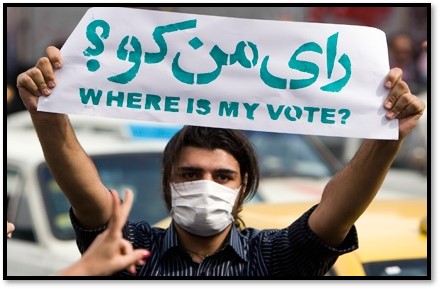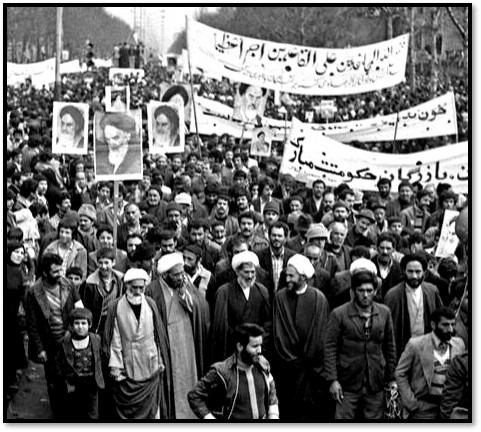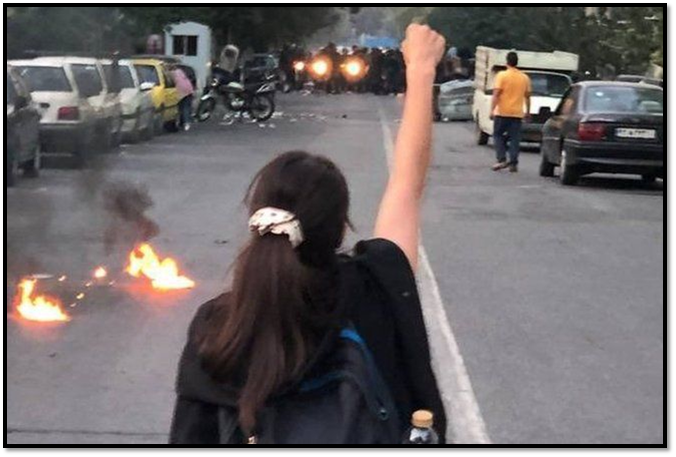How do the 2022 protests compare to previous rounds of demonstrations in 2009, 2017-18, and 2019? What is unique or different this time?
First, the 2022 protests were driven by a demand for greater civil liberties, including women’s rights. They were triggered by the death of Mahsa Amini, a 22-year-old Kurd who was detained for “improper” dress. Initially, demonstrators called for the abolition of the compulsory hijab and morality police. But their demands quickly broadened to include calling for a transition away from the Islamic Republic. Protestors chanted against the highest authority, Supreme Leader Ayatollah Ali Khamenei.

In contrast, the 2009 protests were driven by a narrower demand for government accountability. Millions of Iranians took to the streets following the disputed reelection of President Mahmoud Ahmadinejad. The rallying cry of the Green Movement was “Where is my vote?” The demonstrations were nominally led by presidential candidates Mir Hossein Mousavi, a former prime minister, and Mehdi Karroubi, a former speaker of parliament. They pushed for reform within the framework of the Islamic Republic.
Other rounds of demonstrations were sparked by economic grievances. The 2017-2018 protests were over high prices of basic goods. And the 2019 demonstrations were triggered by an overnight gas price hike.
Second, women and schoolgirls spearheaded the 2022 protests. This was unprecedented. Women participated in other protest movements but did not play a central role.
Third, virtually all sectors of society joined the 2022 protests. This was surprising because Amini was a Sunni and a Kurd, a minority on two counts. Some 90 percent of Iranians are Shiite, and Persians are the largest ethnic group. Yet Amini’s death resonated across ethnic, sectarian, class, and rural vs. urban divides. The protests took on the feel of a national movement because of the diversity of the participants. People from all walks of life coalesced around a clarion call for civil liberties. In contrast, the 2009 protests were largely fueled by members of the urban middle class.
Fourth, the 2022 protests lasted longer than the protests in 2017-2018 and 2019. Each of those rounds lost steam after about two weeks. But the 2022 protests had endured for five weeks and counting as of mid-October. The 2009 protests occurred over six months, but days or weeks sometimes passed between demonstrations.
Dozens of universities and thousands of contract oil workers went on strike to support the protests. Shopkeepers in Tehran’s Grand Bazaar also shut down in solidarity with demonstrators. What do those developments mean?
Universities have historically been the crucibles of change in Iran, especially in the runup to the 1979 revolution. In 2022, demonstrations were held at more than a hundred universities nationwide, a significant development. The outpouring of dissent on campuses – such as Sharif University of Technology (known as Iran’s MIT) – that did not have reputations for fervent political activism reflected the extent of the protests.
The strikes by contract oil workers and Tehran’s bazaaris were a notable but nascent trend as of October 2022. Most business owners nationwide were hesitant to close. They had a strong interest in long-term stability, especially given the poor business climate under U.S. sanctions. For example, many businesses on Instagram resumed selling their goods and services within weeks or days of closing. The scattered and unorganized strikes and shutdowns did not impact the national economy.
What role did the oil workers and bazaaris play in the 1979 revolution as well as in subsequent protests?

Both oil workers and bazaaris played integral roles in the success of the 1979 revolution. Oil has historically been Iran’s most important industry. When the oil workers went on strike, the economy started to crumble, and the monarchy weakened further.
The bazaaris were important for two reasons. First, they subsidized the revolution by donating a staggering amount of money to Ayatollah Ruhollah Khomeini’s cause. Second, the bazaaris, many of whom were religious and conservative, were closely intertwined with the clerics. The mosques became important gathering places for bazaaris to voice their grievances and organize plans for strikes. In subsequent decades, neither the oil workers or bazaaris joined demonstrations in significant numbers.
Can you compare the style and size of the #WomanLifeFreedom protests with earlier demonstrations?
The 2022 protests were more widespread than earlier rounds of demonstrations. Demonstrations were held even in small villages with little propensity for political activism. But the protests were small and sporadic. Hundreds gathered on university campuses and in major cities, but many of the protests only involved dozens of people. The duration of protests also varied widely. Some appeared to only last for 15 minutes while others lasted for hours.
The 2009 protests tended to be larger and more organized. Millions took to the streets in long marches through major cities across the country. But the demonstrations were not held daily like the 2022 protests.
How has the government response in 2022 compared with crackdowns on earlier protests?
During earlier protests, the government gave security forces carte blanche. In 2022, the security forces were more reluctant to use deadly force. They appeared to use rubber bullets and tear gas more often than live bullets, although more than 200 people were reportedly killed in the first month of protests. Riot police used paintballs to mark instigators in crowds for later capture. Security forces beat protestors but did not necessarily detain as many of them as in the past. The goal appeared to be to dissuade people from demonstrating again.
Iran’s judiciary chief has ordered judges to issue harsh sentences for the “main elements of riots” as protests continue over the death of Mahsa Amini in police custody https://t.co/ChzIDLoRfu pic.twitter.com/PQ0pWfaLwE
— Al Jazeera English (@AJEnglish) October 13, 2022
The demographics of the protestors may have played into the government’s calculus on the crackdown. Ali Fadavi, the deputy commander of the Revolutionary Guards, claimed that the average age of detained demonstrators was just 15. In mid-October, the U.N. human rights office reported that up to 23 children had been killed in protests. Killing large numbers of minors or women could add more fuel to the demonstrations.
The government response in cyber space was also more targeted than in previous rounds of demonstrations. For example, in 2019, the internet was completely shut down nationwide for 10 days. In some provinces, the blackout lasted longer. The loss of connectivity cost the economy some $240 million in online transactions alone, according to Iran’s E-Commerce Commission.
In 2022, the approach to internet censorship was tailored to provinces and cities depending on the level of unrest. Timing was also a factor. For example, internet service providers often cut mobile data in the evenings in what appeared to be an effort to disrupt communications among protestors and to prevent mobile uploads of photos and videos of protests in real-time. Internet in homes and businesses was not disrupted as much, although the connection was markedly slowed down. In some cases, protestors had to return home to upload videos, which led to a lag in reporting from on the ground.
The government, however, did repeat its tactic of blocking popular social media platforms. In 2022, it restricted access to Instagram and WhatsApp. Iranians had to use Virtual Private Networks (VPNs) to stay connected. The government had blocked Twitter and Facebook in 2009 amid the Green Movement protests. Authorities also had temporarily blocked access to Instagram and Telegram amid the 2017-2018 protests.
What role are women playing in the demonstrations? And how does their role vary from previous rounds of protests?

Women participated in previous rounds of protests but were relatively marginal in terms of their role as participants or organizers. The 2022 movement, however, was sparked by women’s grievances after having faced years of repression by the morality police. And women were central to driving the protests. They boldly confronted security forces.
How have the 2022 protests been organized? Does the organization or leadership model differ from previous protests?
The 2022 movement had no clear leader or organizational model. Demonstrations were mostly organized by groups on social media and networks of friends. Internet blackouts and the blocking of WhatsApp and Instagram made organizing more difficult, so some activists resorted to more traditional mobilization methods, including distributing leaflets house by house or on the streets to the cars and pedestrians. Many of the protests were organized on university campuses. Several students would plan to gather at a certain time and then tell their various networks so that hundreds would show up. In some cases, university students appeared to linger on campuses and spontaneously join marches.
Filmmaker Mani Haghighi was due to join us at the BFI London Film Festival with his film Subtraction. Authorities in Iran confiscated his passport and he could not leave.#LFF supports Haghighi and all filmmakers in their freedom to present their films around the world. pic.twitter.com/vFhja8EnqS
— BFI (@BFI) October 14, 2022
The decentralized nature of the protests complicated attempts to quash them. Unlike previous rounds of demonstrations, authorities turned to silencing celebrities, including athletes, actors, artists, singers, and film directors who have expressed support for the demonstrations. Many were detained or banned from leaving the country. In a video on Instagram, filmmaker Mani Haghighi criticized the dress code and crackdown on protestors. He was later prevented from boarding his flight to London, where he was due to screen his film at the London Film Festival. Ali Karimi, a legendary soccer player with more than 13 million followers on Instagram, expressed support for protestors, especially women. He was then charged in absentia for “unlawful assembly and collusion with the intention of acting against national security.”
Although the 2009 Green Movement did not have a hierarchical structure, many of its leaders and supporters were public figures. So the government knew who to intimidate and imprison. The government staged show trials of prominent activists in fall 2009 and eventually placed the movement’s figureheads, Mousavi and Karroubi, under house arrest in 2011.
Kourosh Ziabari is an Asia Times correspondent, contributor to Foreign Policy, and a 2022 World Press Institute fellow. In September 2022, he was the recipient of a Dag Hammarskjold Fund for Journalists fellowship at the United Nations. From Rasht, Iran, he is a former Chevening scholarship recipient.
